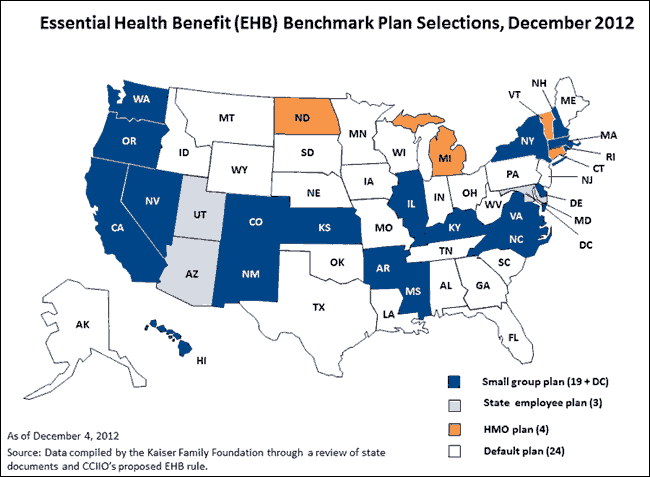Quick Take: Essential Health Benefits: What Have States Decided for Their Benchmark?
Beginning on January 1, 2014, the Affordable Care Act (ACA) requires that all non-grandfathered individual and small group health insurance plans sold in a state, including those offered through an Exchange, cover certain essential health benefits (EHBs).
As it stands today, many plans offered in the individual and small group markets lack access to key benefits; the Department of Health and Human Services (HHS) estimates that 62% of health plan enrollees in the individual market do not have coverage for maternity services and almost one-fifth of enrollees lack mental health service coverage. Essential health benefits, at a minimum, will have to include ambulatory patient services, emergency services, hospitalization, maternity and newborn care, mental health and substance use disorder services, prescription drugs, rehabilitative and habilitative services, laboratory services, preventive and wellness care, chronic disease management, and pediatric dental and vision care. Approximately 68 million people are anticipated to access care covered by the essential health benefit requirement once the ACA is fully implemented.

In a 2011 bulletin and a proposed rule released in November, HHS explained that each state should choose from a range of existing and popular (as measured by enrollment) health insurance plans to serve as an EHB benchmark plan. States can select from the three largest small group health insurance products, the three largest state employee health plan options, the three largest federal employee health plan options, or the largest commercial HMO plan sold in the state. If the state fails to select a benchmark by December 26, 2012, HHS has proposed that the small group health plan with the largest enrollment will be selected by default. The benchmark plan will define the standard set of benefits that must be covered by plans in that state. Insurers in every state will be required to offer plans with benefits “substantially equal” to those found in a state’s benchmark plan. Importantly, the EHB benchmark defines only what benefits must be covered, not what the cost-sharing levels will be. Carriers will develop the cost-sharing features for the products they offer based on the actuarial values for the different metal level plans (bronze, silver, gold, and platinum) spelled out in the ACA.
The ACA specifies that if states require plans to cover services beyond those defined as EHBs by the law, for example certain state-mandated benefits, states must defray the costs of those benefits. However, the proposed rule issued by HHS indicates that for at least 2014 and 2015, if a benchmark plan that is a small group plan or a state employee plan includes state-mandated benefits, those benefits will be considered essential health benefits and the state will not be required to defray any additional costs.
While nearly all states have considered their EHB benchmark options, our review of states’ decisions around EHB shows that only 26 states plus the District of Columbia have already recommended an EHB plan or concluded the default plan is acceptable (see figure above). So far, twenty states and the District of Columbia have selected a small group plan as the state’s EHB benchmark. Three states, Utah, Arizona, and Maryland, chose a state employee health plan as the benchmark. North Dakota, Connecticut, Michigan, and Vermont opted to make their state’s largest commercial HMO plan the EHB benchmark. Nebraska’s Governor submitted an EHB recommendation for a state-defined benefit plan; however, the plan was ultimately not approved by HHS.
Many EHB benchmark plans do not include services in all of the required benefit categories. In those cases, the proposed rule provides that states should identify supplemental coverage to complete their EHB benchmark packages. The proposed rule specifies that, except for habilitative services, the benchmark plan be supplemented by adding benefits for any missing categories from another benchmark plan. For habilitative services, states may define the services to be included in that category or, if they choose not to make that determination, insurers must provide parity with rehabilitative services or define which habilitative services to cover and report to HHS. Almost every state will need to supplement its benchmark plan for pediatric dental and/or pediatric vision services; the proposed rule allows states to select these services from the Federal Employees Dental and Vision Insurance Program (FEDVIP) or the state’s Children’s Health Insurance Program (CHIP). HHS has determined that 20 selected EHB benchmark plans or default plans do not include habilitative services.
Moving forward, HHS will review and approve states’ benchmark recommendations until the December 26, 2012 deadline. With open enrollment in the Exchanges beginning in October 2013, carriers are likely eager for states to finalize their EHB decisions so they can begin analyzing the required benefits and modifying their products to meet the new standards.
